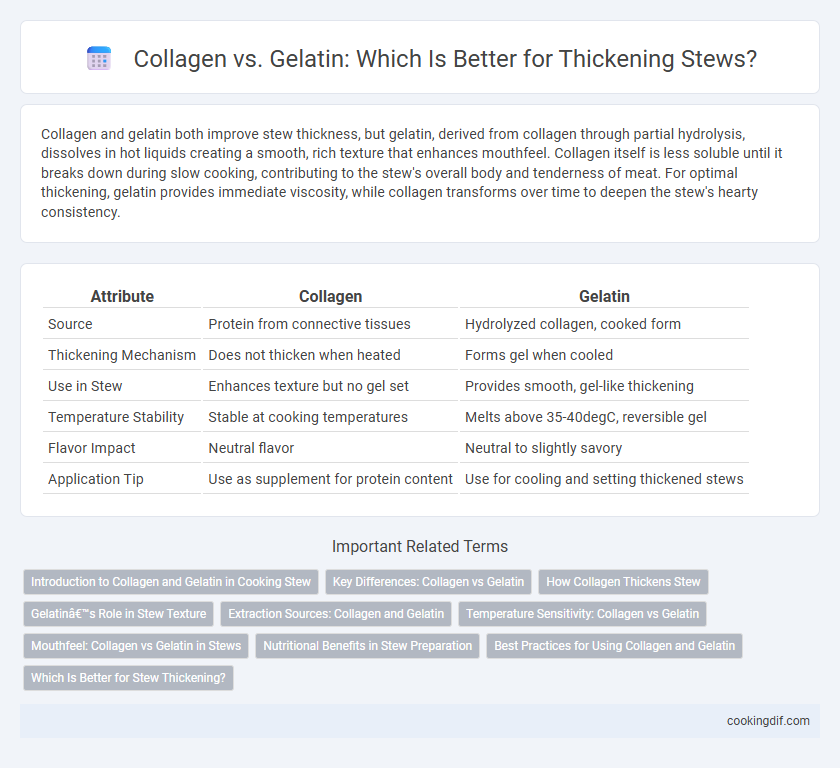Collagen and gelatin both improve stew thickness, but gelatin, derived from collagen through partial hydrolysis, dissolves in hot liquids creating a smooth, rich texture that enhances mouthfeel. Collagen itself is less soluble until it breaks down during slow cooking, contributing to the stew's overall body and tenderness of meat. For optimal thickening, gelatin provides immediate viscosity, while collagen transforms over time to deepen the stew's hearty consistency.
Table of Comparison
| Attribute | Collagen | Gelatin |
|---|---|---|
| Source | Protein from connective tissues | Hydrolyzed collagen, cooked form |
| Thickening Mechanism | Does not thicken when heated | Forms gel when cooled |
| Use in Stew | Enhances texture but no gel set | Provides smooth, gel-like thickening |
| Temperature Stability | Stable at cooking temperatures | Melts above 35-40degC, reversible gel |
| Flavor Impact | Neutral flavor | Neutral to slightly savory |
| Application Tip | Use as supplement for protein content | Use for cooling and setting thickened stews |
Introduction to Collagen and Gelatin in Cooking Stew
Collagen and gelatin both play essential roles in thickening stew by enhancing texture and mouthfeel. Collagen, a structural protein found in connective tissues, breaks down into gelatin during slow cooking, contributing to a rich, velvety consistency. Understanding the transformation from collagen to gelatin helps cooks optimize stew thickness and improve overall flavor depth.
Key Differences: Collagen vs Gelatin
Collagen and gelatin both contribute to stew thickening but differ significantly in structure and function. Collagen is a tough, fibrous protein found in connective tissues that breaks down slowly with prolonged cooking, whereas gelatin is its denatured, partially hydrolyzed form that dissolves readily, creating a smooth, gel-like texture. Gelatin imparts a rich mouthfeel and viscosity ideal for finishing stews, while collagen requires extended simmering to convert and tenderize ingredients.
How Collagen Thickens Stew
Collagen thickens stew by breaking down into gelatin during slow cooking, creating a rich, silky texture that enhances mouthfeel. Unlike plain gelatin, collagen naturally occurs in meat and connective tissues, releasing into the broth to provide a consistent, smooth thickness. This transformation adds both body and nutritional benefits, including amino acids essential for joint health.
Gelatin’s Role in Stew Texture
Gelatin plays a crucial role in enhancing stew texture by breaking down during cooking to create a rich, silky mouthfeel and natural thickness without the graininess sometimes caused by collagen. As collagen converts to gelatin through slow simmering, it helps bind the broth and ingredients, resulting in a smooth and cohesive consistency. Using gelatin-rich cuts like beef shank or oxtail boosts this effect, elevating the stew's overall body and depth.
Extraction Sources: Collagen and Gelatin
Collagen is a structural protein extracted primarily from animal connective tissues such as skin, bones, and cartilage, providing the basis for gelatin when hydrolyzed through heating or enzymatic processes. Gelatin, derived from collagen through partial hydrolysis, dissolves in hot liquids and forms a gel upon cooling, making it a popular thickening agent in stews and soups. Understanding the extraction sources highlights how gelatin's gel-forming properties differ from collagen's native fibrillar structure, influencing texture and mouthfeel in culinary applications.
Temperature Sensitivity: Collagen vs Gelatin
Collagen and gelatin differ significantly in temperature sensitivity when used for thickening stews; collagen requires prolonged cooking at higher temperatures to break down into gelatin, which then thickens the liquid. Gelatin dissolves quickly at lower temperatures, readily thickening the stew as it cools, creating a smooth, rich texture. Understanding these temperature dynamics ensures optimal stew consistency and mouthfeel by leveraging collagen's gradual transformation and gelatin's immediate gelling properties.
Mouthfeel: Collagen vs Gelatin in Stews
Gelatin creates a silky, smooth mouthfeel in stews due to its ability to dissolve and gel upon cooling, enhancing the broth's richness and body. Collagen, when cooked slowly, breaks down into gelatin, contributing to a tender texture but without the immediate thickening effect. Using gelatin directly results in a more pronounced, luscious mouth-coating sensation, while collagen imparts subtle, long-lasting softness to meats and vegetables.
Nutritional Benefits in Stew Preparation
Collagen and gelatin both contribute to thickening stew by enhancing its texture and mouthfeel, but their nutritional benefits differ significantly. Collagen supports joint health and skin elasticity, providing essential amino acids that are preserved in slow-cooked stews, while gelatin offers improved digestion and gut health due to its partially broken-down collagen peptides. Incorporating bone broth rich in collagen and gelatin into stew not only thickens it naturally but also boosts its nutrient density for better overall wellness.
Best Practices for Using Collagen and Gelatin
Collagen and gelatin both enhance stew thickness, but gelatin dissolves quickly and gels upon cooling, ideal for consistent texture in refrigerated dishes. Use collagen peptides for smooth, non-gelling thickening that maintains clarity and resists heat breakdown, perfect for hot stews needing a glossy finish. For best results, dissolve gelatin in cold water before adding to simmering stew, while collagen peptides mix easily into hot liquids without clumping.
Which Is Better for Stew Thickening?
Gelatin and collagen both enhance stew texture, but gelatin provides superior thickening due to its ability to dissolve in hot liquids and form a gel upon cooling. Collagen, found in connective tissues, converts to gelatin when cooked slowly, making natural collagen-rich cuts ideal for stews. Using pure gelatin powder offers consistent thickness quickly, while collagen hydrolysate lacks gelling properties and won't thicken stews effectively.
Collagen vs Gelatin for thickening Infographic

 cookingdif.com
cookingdif.com